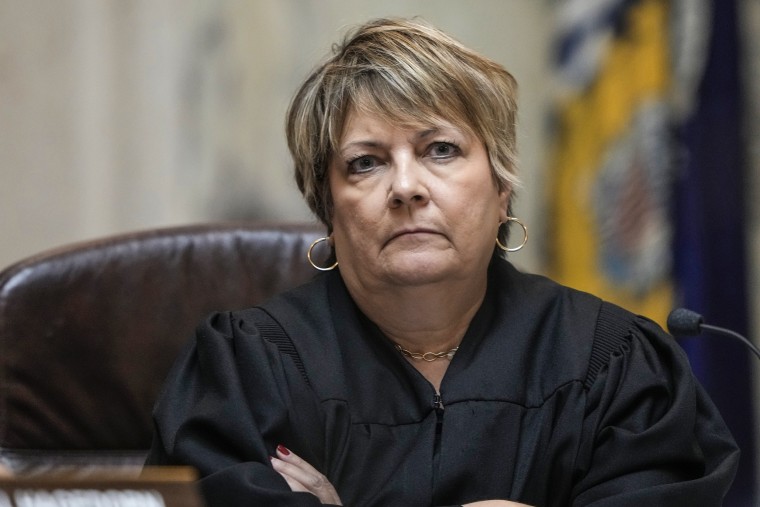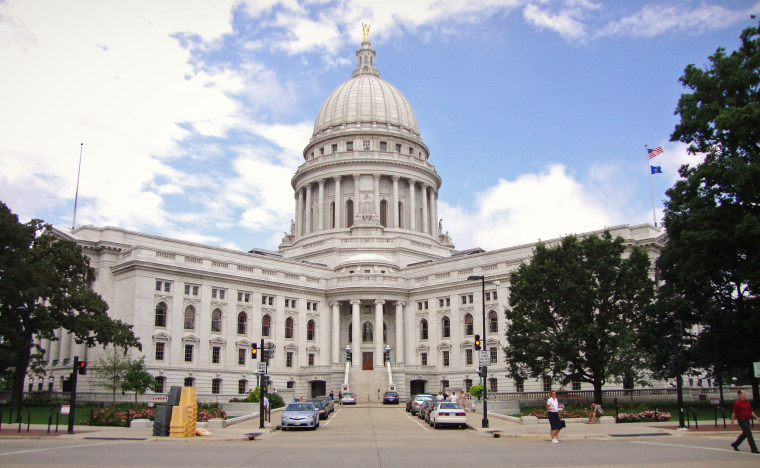Tense opening arguments kicked off Tuesday at the Wisconsin Supreme Court in a suit challenging the state’s heavily gerrymandered legislative maps — a case whose outcome has the potential to alter the politics within the closely watched swing state.
The first major case to be heard by the court’s new liberal majority has emerged as a flashpoint for the state’s purple politics. The three hours of arguments Tuesday morning in Madison, the capital, were preceded by partisan rancor and attacks, which continued throughout the arguments.
Attorneys for 19 Democratic voters filed the suit in August directly with the Supreme Court — just days after liberals formally took control of its majority for the first time in 15 years — asking the bench to rule that the state’s legislative maps are unconstitutional and to order that new maps be drawn by March. Gov. Tony Evers and Attorney General Josh Kaul, both Democrats, quickly joined the suit. Experts have said the state’s current map is one of the most gerrymandered in the U.S.
While the court is technically nonpartisan, its seven justices have nonetheless made their ideological leanings clear. During Tuesday’s arguments, its three conservative members aggressively questioned Democratic attorneys over why the bench was being asked to strike down maps it agreed on just a year ago, repeatedly suggesting that the reason was political.
“Everybody knows that the reason we’re here is because there was a change in the membership on the court. You would not have brought this action — right? — if the newest justice had lost,” said Justice Rebecca Bradley, one of the court’s conservatives.
Bradley was referring to Janet Protasiewicz, whose resounding April victory swung control of the court to liberals.
During her campaign, Protasiewicz criticized the state’s maps as being “unfair” and “rigged” — comments that conservatives argue amounted to her having forecast how she would rule on the issue. They have demanded that she recuse herself from the case — Protasiewicz has declined to do so — and some Republicans have threatened to impeach her.

That conflict has also been at the center of infighting on the court itself — tensions that were again on display during Tuesday’s proceedings, with justices constantly interrupting attorneys and one another.
During one particularly fraught exchange over whether the court had the constitutional authority to decide on maps, Bradley talked over liberal Justice Jill Karofsky, who had interrupted her.
“I’d like an answer to my question, justice, first,” Bradley said. “Are you arguing the case?”
The court’s four liberal justices, including Protasiewicz, spent much of their time asking attorneys about the criteria and rules by which new maps would be drawn if their ruling were to mandate that.
The state’s current map was approved last year by the state Supreme Court’s previous conservative majority after Evers and the GOP-controlled Legislature couldn’t agree on maps. (As is the case in many states, if the governor and the Legislature in Wisconsin cannot agree on legislative maps, the issue falls to the state Supreme Court.)
Democratic attorneys have based their suit that the current maps must be thrown out largely on two claims.
One is that the map is unconstitutional because it violates the state constitution’s requirement that districts be contiguous — a complicated and poorly defined rule mandating that legislative districts be physically adjacent to one another. Critics of the current maps note that some Wisconsin districts include “islands” (or detached areas) within other districts. Some have compared the state’s map to Swiss cheese. Justices and attorneys spent the bulk of Tuesday’s arguments debating how to best define the concept of "contiguity" so that future maps comply with the requirement.
The suit also argues that the state Supreme Court violated the separation of powers laws in 2022 after it approved a map that had been vetoed by Evers in 2021. Attorneys arguing in favor of keeping the current maps often brought up that the separation of powers clause couldn’t have been violated because the constitution also makes clear that the decision on maps falls to the state Supreme Court if the governor and Legislature are deadlocked.
Wisconsin’s current legislative maps heavily favor Republicans — who control 64 of the 99 seats in the state Assembly and 22 of the 33 in the state Senate — despite the fact that the last two presidential elections have both been decided by less than 1 percentage point in the state and the last two gubernatorial races have both been decided by less than 4 points.
At stake in a ruling to throw out the current maps would be not just the maps themselves, but the fate of decades of conservative laws in the perennial battleground state, as well.
A decision by the court to order new maps could put every member of the Legislature up for re-election in 2024. Such a ruling could mean that some lawmakers would have to run in new districts, in November special elections, for fresh two-year terms (including state senators, all of whom would only be partially through four-year terms).
While such a ruling almost certainly wouldn’t swing Republican control of either chamber to Democrats, it would likely weaken the GOP’s hold in both — the party has controlled each for 12 years — according to recent analyses of the maps by the Milwaukee Journal Sentinel and The Associated Press. That, in turn, could help boost efforts to reverse years of conservative policies in the state on issues related to election administration, unions and abortion. New maps could also shift Republicans further away from a supermajority (the party currently has one in the state Senate and is only two seats short of having one in the state Assembly), and with it, the ability to overturn Evers’ vetoes.
Also underlying Tuesday’s tense proceedings was the growing political acrimony that resulted from Protasiewicz’s victory this year.
Her criticism of the maps — as well as her support of abortion rights — was at the center of her successful campaign, and the issues have remained hot-button topics since she was sworn in over the summer.
Wisconsin Republican lawmakers began openly talking about the possibility of impeaching her just days after her April victory. State Assembly Speaker Robin Vos, a Republican, directed a panel of former members of the Wisconsin Supreme Court to provide him with an analysis regarding whether impeachment of Protasiewicz was possible.
Her refusal to recuse from the case — outlined in a lengthy brief filed last month in which she explained that she had never suggested that she wouldn’t hear the case fairly despite having offered various critical opinions of the state’s legislative maps — only served to amplify those calls.
Members of the secretive group assembled by Vos, however, eventually advised him to not move forward with impeachment, though Vos has yet to rule it out. He suggested last month that he could still move to do so if Protasiewicz rules against the current maps.

